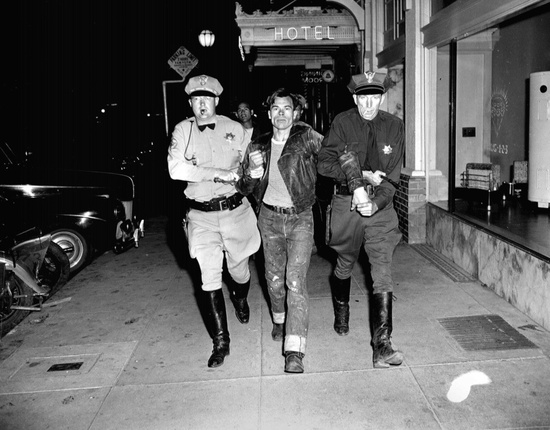Gamma68
One Too Many
- Messages
- 1,936
- Location
- Detroit, MI
After viewing "The Wild One" again recently, I started wondering about the event that inspired the film. I did some reading on the so-called "1947 Hollister Riot" and was a little struck by the scarcity of Perfecto-style leather jackets--or any leather jackets--in the photos of the bikers.
Here are some of the images I've seen identified as being taken at that event. Most seem to show townspeople but the bikers supposedly took over the streets.


Another shows two bikers without jackets.

The only image I've seen of what might be a Perfecto-style jacket at the event is this one (although there must have been others):

And of course, there is the famous staged photo that launched the myth of the crazed, dangerous boozing biker:

But none of the photos depict anyone quite like Johnny Strabler--an image that quickly became iconic and to a large degree remains a symbol of the prototypical American Biker.

With this contrast in style between the 1947 event and the 1953 film, I wondered how the bikers were depicted in "Cyclists' Raid"--the short story by Frank Rooney. "The Wild One" is based upon this story. It appeared in the Jan. 1951 issue of "Harper's Magazine."
Here's how the narrator describes club leader Gar Simpson and the other bikers:
"Like all the others he was dressed in a brown windbreaker, khaki shirt, khaki pants, and as Bleeker observed wore dark calf-length boots. A cloth and leather helmet lay on the table beside Simpson's drink, but he hadn't removed his flat green goggles, an accouterment giving him and the men in his troop the appearance of some tropical tribe with enormous semi-precious eyes, lidless and immovable."
Pulp artist David Berger supplied illustrations for the story, which diverge from both the actual Hollister event and the image of Strabler:


So it seems the depiction of Johnny Strabler, the iconic image of the American Biker, is based to a large degree on mythical fancy. Which leads to the question: who is the original "Wild One" -- the infamous drunken Hollister resident? The character illustrated in "Cyclists' Raid"? Or has the Johnny Strabler image become so pervasive over time that it is has assumed the position of the true prototype?
Here are some of the images I've seen identified as being taken at that event. Most seem to show townspeople but the bikers supposedly took over the streets.


Another shows two bikers without jackets.

The only image I've seen of what might be a Perfecto-style jacket at the event is this one (although there must have been others):
And of course, there is the famous staged photo that launched the myth of the crazed, dangerous boozing biker:

But none of the photos depict anyone quite like Johnny Strabler--an image that quickly became iconic and to a large degree remains a symbol of the prototypical American Biker.

With this contrast in style between the 1947 event and the 1953 film, I wondered how the bikers were depicted in "Cyclists' Raid"--the short story by Frank Rooney. "The Wild One" is based upon this story. It appeared in the Jan. 1951 issue of "Harper's Magazine."
Here's how the narrator describes club leader Gar Simpson and the other bikers:
"Like all the others he was dressed in a brown windbreaker, khaki shirt, khaki pants, and as Bleeker observed wore dark calf-length boots. A cloth and leather helmet lay on the table beside Simpson's drink, but he hadn't removed his flat green goggles, an accouterment giving him and the men in his troop the appearance of some tropical tribe with enormous semi-precious eyes, lidless and immovable."
Pulp artist David Berger supplied illustrations for the story, which diverge from both the actual Hollister event and the image of Strabler:


So it seems the depiction of Johnny Strabler, the iconic image of the American Biker, is based to a large degree on mythical fancy. Which leads to the question: who is the original "Wild One" -- the infamous drunken Hollister resident? The character illustrated in "Cyclists' Raid"? Or has the Johnny Strabler image become so pervasive over time that it is has assumed the position of the true prototype?
Last edited:






/2015%2F05%2F18%2F68%2FHollister19.9a335.jpg)